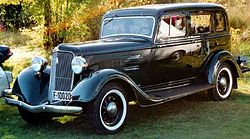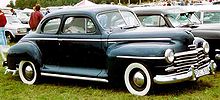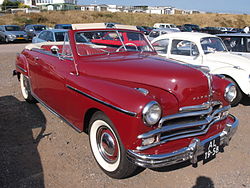Plymouth Deluxe
| Plymouth Deluxe / Special Deluxe | |
|---|---|
| Production period: | 1933-1942 1946-1950 |
| Class : | upper middle class |
| Body versions : | Limousine , Pullman limousine , station wagon , coupé , convertible |
| Previous model: | New Finer Plymouth |
| Successor: | Concord , Cambridge , Cranbrook |
The Plymouth Deluxe was a large passenger car that Chrysler manufactured under the brand name Plymouth in the model years 1933-1942 and 1946-1950. It replaced the New Finer Plymouth and was the best equipped series in the years up to 1942. From 1941 an even better equipped Plymouth Special Deluxe was also offered. In 1946, it was the brand's first car after the Second World War . Cabriolet and station wagon were only available as Special Deluxe. In 1951 he was replaced by the trio of Concord , Cambridge and Cranbrook .
Year by year
Model PD (1933)
| PD | |
|---|---|
|
Image does not exist |
|
| Production period: | 1933 |
| Body versions : | Sedan , coupe , convertible |
| Engines: |
Otto engine : 3.1 liters (51 kW) |
| Length: | 4534 mm |
| Width: | |
| Height: | |
| Wheelbase : | 2845 mm |
| Empty weight : | 1126-1198 kg |
That year Plymouth offered its first six-cylinder car, the Standard (model PC) . Together with the more luxuriously equipped model PD (Deluxe) it replaced the New Finer Plymouth of the previous year with only 4 cylinders. It was developed from the Dodge model DP, on whose chassis with a 2844 mm wheelbase a longer body was placed.
In addition to a 4-door sedan, various 2-door bodies were also available. There was also a chassis without a body for customers who wanted to have a “custom” body made by the body cutter.
The new cars were powered by a six-cylinder in-line engine with side-mounted valves and a displacement of 3110 cm³, which made 70 bhp (51 kW) at 3600 rpm. The engine power was passed on to the rear wheels via a single-disc dry clutch and a 3-speed gearbox with center shift. All four wheels, which could be wire-spoke or wooden-spoke wheels, were hydraulically braked.
Model PE (1934)
| PE | |
|---|---|
|
Plymouth Deluxe PE Sedan (1934) |
|
| Production period: | 1934 |
| Body versions : | Limousine , Pullman limousine , station wagon , coupé , convertible |
| Engines: |
Otto engine : 3.3 liters (56.5 kW) |
| Length: | 4605-4759 mm |
| Width: | |
| Height: | |
| Wheelbase : | 2896 mm |
| Empty weight : | 1209-1313 kg |
In the following year, the Deluxe received a larger engine with a displacement of 3299 cm³, which delivered 77 bhp (56.6 kW) at 3600 rpm. The wheelbase had grown by 2 ″ to 2896 mm. In addition, it was one of the first inexpensive cars to receive coil springs instead of leaf springs. Also new was a 5-door station wagon, the load compartment of which consisted of a sheet-metal wooden frame (“woody”).
Models PJ, P2, P4 and P6 (1935–1938)
| PJ / P2 / P4 / P6 | |
|---|---|
|
Plymouth PJ Deluxe 2-door Touring Sedan (1935) |
|
| Production period: | 1935-1938 |
| Body versions : | Limousine , Pullman limousine , station wagon , coupé , convertible |
| Engines: |
Otto engine : 3.3 liters (60 kW) |
| Length: | 4684-5440 mm |
| Width: | |
| Height: | |
| Wheelbase : | 2845-3353 mm |
| Empty weight : | 1216-1490 kg |
The PJ model - a model name for all equipment lines this year - had been completely redesigned. The wheelbase of the new X-frame was a uniform 2870 mm. The bodies were rounder and there were now also sedans with a separate trunk, known as "touring sedans". The doors were now hinged at the front instead of the back. The output of the 3.3 liter engine increased to 82 bhp (60 kW).
The Deluxe, model P2, appeared in 1936. The car was redesigned again - chassis and sheet metal thicknesses were fundamentally different - but looked very similar to the PJ model from the previous year. Customers only saw this as a facelift .
The 1937 model P4 had a 1 ″ shorter wheelbase (2845 mm), but the bodies were longer than in the previous year. The radiator grille was a bit more rounded and, with its central bar, looked not dissimilar to the contemporary BMW models.
In 1938 the P6 model appeared, the fenders of which were pulled even further forward. Overall, the vehicles made a stocky impression, which was not well received by the audience. Ironically, in this anniversary year (10 years of Plymouth) the sales figures collapsed, although the new model now offered safety glass all around and in the dashboard for safety reasons.
Model P8 (1939)
| P8 | |
|---|---|
|
Plymouth P8 Deluxe Sedan (1939) |
|
| Production period: | 1939 |
| Body versions : | Limousine , Pullman limousine , station wagon , coupé , convertible |
| Engines: |
Petrol engines : 3.3 liters (60–63 kW) |
| Length: | |
| Width: | |
| Height: | |
| Wheelbase : | 2896-3403 mm |
| Empty weight : | 1263-1528 kg |
Due to the failure of the previous year's models, a new design was actually inevitable, but the necessary money was missing. The existing bodies were modernized, especially on the front end: the one-piece windshield was replaced by a split version in a slightly V-shape, the individual headlights disappeared into the front fenders (on some models they were given a rectangular shape) and the radiator grille got one modern narrow shape with additional grids in the lower area. As a result of these measures, the wheelbase grew back to 2896 mm.
In addition to a delivery van (with sheet metal side windows), this year there was also the first convertible in automobile history with an electrically operated fabric roof. As an alternative, a standard machine with 82 bhp, there was a motor with 86 bhp (63 kW) on request.
Models P10, P11, P11D and P12 (1940–1941)
| P10 / P11 / P11D / P12 | |
|---|---|
|
Plymouth P12 Deluxe Coupe (1941) |
|
| Production period: | 1940-1941 |
| Body versions : | Limousine , Pullman limousine , station wagon , coupé , convertible |
| Engines: |
Petrol engines : 3.3 liters (62–68 kW) |
| Length: | 4940-5609 mm |
| Width: | |
| Height: | |
| Wheelbase : | 2972-3493 mm |
| Empty weight : | 1266-1536 kg |
This year there was finally the urgently needed new body that the other brands in the Chrysler Group had already received last year. The wheelbase of the P10 model was now 2972 mm. As the engine moved forwards and the rear axle to the rear, the passenger compartment increased significantly in volume. All models have now also been equipped with heating and ventilation. Despite the completely new bodywork, the cars looked not dissimilar to the previous year's models; only the radiator grille received chrome strips. The performance of the two engines increased to 84 bhp (62 kW) and 87 bhp (64 kW).
The 1941 models looked very similar to the previous year's models, but came up with significant changes: The split hood from the previous year, hinged in the middle, gave way to an "alligator hood" hinged at the back. The engines mounted underneath now developed 87 bhp (64 kW) or 92 bhp (68 kW). In addition to the normal deluxe models P11 and P11D, the even better equipped Special Deluxe models P12 were also offered. They had two-tone paintwork and the “Woody” combos could be ordered in two different shades of wood according to customer requirements (the wood came from the ash in each case ). Cabriolet and station wagon were only available as Special Deluxe.
Models P14S, P14C and P15 (1942, 1946–1948)
| P14S / P14C / P15 | |
|---|---|
|
Plymouth Special Deluxe Coupe (1948) |
|
| Production period: | 1942 1946-1948 |
| Body versions : | Sedan , station wagon , coupé , convertible |
| Engines: |
Otto engine : 3.6 liters (70 kW) |
| Length: | 4967-4997 mm |
| Width: | |
| Height: | |
| Wheelbase : | 2972 mm |
| Empty weight : | 1327-1541 kg |
The 1942 models appeared in mid-1941 and production ended due to the war at the end of January 1942. Compared to the previous year's models, the radiator grille was flatter and wider and the side running boards were no longer available. The old X-frame was also sent to old age. Deluxe (P14S) and Special Deluxe (P14C) models were now the only passenger cars offered by Plymouth. Chrome was saved with the deluxe models in particular; some vehicles even had painted chrome and camouflage paintwork. There was now only one engine again, which, however, drew 95 bhp (70 kW) from a displacement of 3569 cm³.
In 1946, exactly these models were used to resume car production with minor changes. The grille and front bumper were a little different. In 1947, the P15 models continued to be built without any changes. The only change in 1948 was the change from 16 ″ wheels to 15 ″ wheels. These models were discontinued in March 1949.
Models P17, P18, P19 and P20 (1949–1950)
| P17 / P18 / P19 / P20 | |
|---|---|
|
Plymouth De Luxe Cabriolet (1950) |
|
| Production period: | 1949-1950 |
| Body versions : | Sedan , station wagon , coupé , convertible |
| Engines: |
Otto engine : 3.6 liters (71 kW) |
| Length: | 4707-4893 mm |
| Width: | |
| Height: | |
| Wheelbase : | 2819-3010 mm |
| Empty weight : | 1335-1519 kg |
From April 1949 there was a version with a short wheelbase of the Deluxe. Stylistically, the new models were similar to those of the previous year, but the wheelbase of the P17 was only 2819 mm. Accordingly, there were only two-door bodies. In addition, there was still the Deluxe on a normal chassis (model P18) with a now 3010 mm wheelbase with 2-, 4- and 5-door bodies. The Special Deluxe was only available on the normal chassis. The power of the 3.6 liter engine had increased to 97 bhp (71 kW).
All three model series were adopted as P19 and P20 in the 1950 model year with minimal changes. On January 12, 1951, they were replaced by successor models Concord , Cambridge and Cranbrook .
Web links
swell
- Beverly R. Kimes, Henry A. Clark: Standard Catalog of American Cars 1805-1942. Krause Publications, Iola 1985, ISBN 0-87341-045-9 .
- John Gunnell (Ed.): Standard Catalog of American Cars 1946-1975. Krause Publications, Iola 2002, ISBN 0-87349-461-X .







